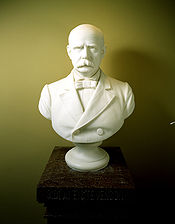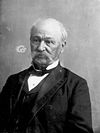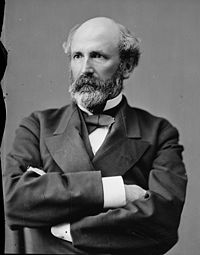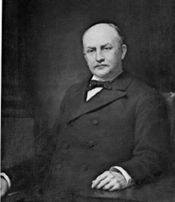
53rd United States Congress
Encyclopedia
The Fifty-third United States Congress was a meeting of the legislative branch of the United States federal government, consisting of the United States Senate
and the United States House of Representatives
. It met in Washington, D.C.
from March 4, 1893 to March 4, 1895, during the fifth and sixth years of Grover Cleveland
's presidency. The apportionment of seats in the House of Representatives
was based on the Eleventh Census of the United States in 1890
. Both chambers had a Democratic
majority.
TOTAL members: 88
TOTAL members: 356

, which indicate the cycle of their election. In this Congress, Class 1 meant their term began in this Congress, requiring reelection in 1898; Class 2 meant their term ended in this Congress, requiring reelection in 1894; and Class 3 meant their term began in the last Congress, requiring reelection in 1896.
United States Senate
The United States Senate is the upper house of the bicameral legislature of the United States, and together with the United States House of Representatives comprises the United States Congress. The composition and powers of the Senate are established in Article One of the U.S. Constitution. Each...
and the United States House of Representatives
United States House of Representatives
The United States House of Representatives is one of the two Houses of the United States Congress, the bicameral legislature which also includes the Senate.The composition and powers of the House are established in Article One of the Constitution...
. It met in Washington, D.C.
Washington, D.C.
Washington, D.C., formally the District of Columbia and commonly referred to as Washington, "the District", or simply D.C., is the capital of the United States. On July 16, 1790, the United States Congress approved the creation of a permanent national capital as permitted by the U.S. Constitution....
from March 4, 1893 to March 4, 1895, during the fifth and sixth years of Grover Cleveland
Grover Cleveland
Stephen Grover Cleveland was the 22nd and 24th president of the United States. Cleveland is the only president to serve two non-consecutive terms and therefore is the only individual to be counted twice in the numbering of the presidents...
's presidency. The apportionment of seats in the House of Representatives
United States House of Representatives
The United States House of Representatives is one of the two Houses of the United States Congress, the bicameral legislature which also includes the Senate.The composition and powers of the House are established in Article One of the Constitution...
was based on the Eleventh Census of the United States in 1890
United States Census, 1890
The Eleventh United States Census was taken June 2, 1890. The data was tabulated by machine for the first time. The data reported that the distribution of the population had resulted in the disappearance of the American frontier...
. Both chambers had a Democratic
Democratic Party (United States)
The Democratic Party is one of two major contemporary political parties in the United States, along with the Republican Party. The party's socially liberal and progressive platform is largely considered center-left in the U.S. political spectrum. The party has the lengthiest record of continuous...
majority.
Party summary
The count below identifies party affiliations at the beginning of the first session of this Congress, and includes members from vacancies and newly admitted states, when they were first seated. Changes resulting from subsequent replacements are shown below in the "Changes in membership" section.Senate
- DemocraticDemocratic Party (United States)The Democratic Party is one of two major contemporary political parties in the United States, along with the Republican Party. The party's socially liberal and progressive platform is largely considered center-left in the U.S. political spectrum. The party has the lengthiest record of continuous...
: 44 (majority) - RepublicanRepublican Party (United States)The Republican Party is one of the two major contemporary political parties in the United States, along with the Democratic Party. Founded by anti-slavery expansion activists in 1854, it is often called the GOP . The party's platform generally reflects American conservatism in the U.S...
: 37 - PopulistPopulist Party (United States)The People's Party, also known as the "Populists", was a short-lived political party in the United States established in 1891. It was most important in 1892-96, then rapidly faded away...
: 3 - SilverSilver PartyThe Silver Party was a political party in the United States, most successful in Nevada, active from 1892-1911. The party supported a platform of bimetallism and "Free Silver."...
: 1 - Vacant, due to failure to elect. Later filled by Republicans: 3
TOTAL members: 88
House of Representatives
- DemocraticDemocratic Party (United States)The Democratic Party is one of two major contemporary political parties in the United States, along with the Republican Party. The party's socially liberal and progressive platform is largely considered center-left in the U.S. political spectrum. The party has the lengthiest record of continuous...
: 218 (majority) - RepublicanRepublican Party (United States)The Republican Party is one of the two major contemporary political parties in the United States, along with the Democratic Party. Founded by anti-slavery expansion activists in 1854, it is often called the GOP . The party's platform generally reflects American conservatism in the U.S...
: 124 - PopulistPopulist Party (United States)The People's Party, also known as the "Populists", was a short-lived political party in the United States established in 1891. It was most important in 1892-96, then rapidly faded away...
: 11 - SilverSilver PartyThe Silver Party was a political party in the United States, most successful in Nevada, active from 1892-1911. The party supported a platform of bimetallism and "Free Silver."...
: 1 - Independent DemocraticDemocratic Party (United States)The Democratic Party is one of two major contemporary political parties in the United States, along with the Republican Party. The party's socially liberal and progressive platform is largely considered center-left in the U.S. political spectrum. The party has the lengthiest record of continuous...
: 2
TOTAL members: 356
Leadership

- Senate
- Vice President of the United StatesVice President of the United StatesThe Vice President of the United States is the holder of a public office created by the United States Constitution. The Vice President, together with the President of the United States, is indirectly elected by the people, through the Electoral College, to a four-year term...
(President of the Senate):- Adlai E. Stevenson, of IllinoisIllinoisIllinois is the fifth-most populous state of the United States of America, and is often noted for being a microcosm of the entire country. With Chicago in the northeast, small industrial cities and great agricultural productivity in central and northern Illinois, and natural resources like coal,...
- Adlai E. Stevenson, of Illinois
- President pro tempore of the SenatePresident pro tempore of the United States SenateThe President pro tempore is the second-highest-ranking official of the United States Senate. The United States Constitution states that the Vice President of the United States is the President of the Senate and the highest-ranking official of the Senate despite not being a member of the body...
:- Charles Frederick MandersonCharles F. MandersonCharles Frederick Manderson was a United States Senator from Nebraska from 1883 to 1895.-Biography:Born in Philadelphia, Pennsylvania, he attended school there and then moved to Canton, Ohio, in 1856, where he studied law...
, RepublicanRepublican Party (United States)The Republican Party is one of the two major contemporary political parties in the United States, along with the Democratic Party. Founded by anti-slavery expansion activists in 1854, it is often called the GOP . The party's platform generally reflects American conservatism in the U.S...
of NebraskaNebraskaNebraska is a state on the Great Plains of the Midwestern United States. The state's capital is Lincoln and its largest city is Omaha, on the Missouri River....
, reelected March 4, 1893. - Isham Green HarrisIsham G. HarrisIsham Green Harris was an American politician. He served as Governor of Tennessee from 1857 to 1862 and as a U.S. Senator from 1877 until his death....
, DemocraticDemocratic Party (United States)The Democratic Party is one of two major contemporary political parties in the United States, along with the Republican Party. The party's socially liberal and progressive platform is largely considered center-left in the U.S. political spectrum. The party has the lengthiest record of continuous...
of TennesseeTennesseeTennessee is a U.S. state located in the Southeastern United States. It has a population of 6,346,105, making it the nation's 17th-largest state by population, and covers , making it the 36th-largest by total land area...
, elected March 22, 1893. - Matt Whitaker Ransom, DemocraticDemocratic Party (United States)The Democratic Party is one of two major contemporary political parties in the United States, along with the Republican Party. The party's socially liberal and progressive platform is largely considered center-left in the U.S. political spectrum. The party has the lengthiest record of continuous...
of North CarolinaNorth CarolinaNorth Carolina is a state located in the southeastern United States. The state borders South Carolina and Georgia to the south, Tennessee to the west and Virginia to the north. North Carolina contains 100 counties. Its capital is Raleigh, and its largest city is Charlotte...
, elected January 7, 1895. - Isham Green HarrisIsham G. HarrisIsham Green Harris was an American politician. He served as Governor of Tennessee from 1857 to 1862 and as a U.S. Senator from 1877 until his death....
, DemocraticDemocratic Party (United States)The Democratic Party is one of two major contemporary political parties in the United States, along with the Republican Party. The party's socially liberal and progressive platform is largely considered center-left in the U.S. political spectrum. The party has the lengthiest record of continuous...
of TennesseeTennesseeTennessee is a U.S. state located in the Southeastern United States. It has a population of 6,346,105, making it the nation's 17th-largest state by population, and covers , making it the 36th-largest by total land area...
, elected January 10, 1895.
- Charles Frederick Manderson
- Vice President of the United States
- House of Representatives
- Speaker of the HouseSpeaker of the United States House of RepresentativesThe Speaker of the United States House of Representatives, or Speaker of the House, is the presiding officer of the United States House of Representatives...
- Charles F. CrispCharles Frederick CrispCharles Frederick Crisp was a United States political figure. A Democrat, he was elected as a Congressman from Georgia in 1882, and served until his death in 1896. From 1890 until his death, he was leader of the Democratic Party in the House, as either the House Minority Leader or the Speaker of...
, DemocraticDemocratic Party (United States)The Democratic Party is one of two major contemporary political parties in the United States, along with the Republican Party. The party's socially liberal and progressive platform is largely considered center-left in the U.S. political spectrum. The party has the lengthiest record of continuous...
of GeorgiaGeorgia (U.S. state)Georgia is a state located in the southeastern United States. It was established in 1732, the last of the original Thirteen Colonies. The state is named after King George II of Great Britain. Georgia was the fourth state to ratify the United States Constitution, on January 2, 1788...
, reelected August 7, 1893.
- Charles F. Crisp
- Speaker of the House
Major events
- Main article: Events of 1893; Events of 1894; Events of 1895
- March 4, 1893 Grover ClevelandGrover ClevelandStephen Grover Cleveland was the 22nd and 24th president of the United States. Cleveland is the only president to serve two non-consecutive terms and therefore is the only individual to be counted twice in the numbering of the presidents...
became President of the United StatesPresident of the United StatesThe President of the United States of America is the head of state and head of government of the United States. The president leads the executive branch of the federal government and is the commander-in-chief of the United States Armed Forces....
for a second time.
- March 4, 1893 Grover Cleveland
Major legislation
- August 27, 1894: Wilson-Gorman Tariff ActWilson-Gorman Tariff ActThe Revenue Act or Wilson-Gorman Tariff of 1894 slightly reduced the United States tariff rates from the numbers set in the 1890 McKinley tariff and imposed a 2% income tax. It is named for William L. Wilson, Representative from West Virginia, chair of the U.S. House Ways and Means Committee, and...
, ch. 349, §73, - February 18, 1895: Maguire Act of 1895Maguire Act of 1895The Maguire Act of 1895 is a United States Federal statute that abolished the practice of imprisoning sailors who deserted from coastwise vessels. The act was sponsored by representative James G. Maguire of San Francisco, California....
,
Members
This list is arranged by chamber, then by state. Senators are listed in order of seniority, and Representatives are listed by district.Senate
Senators were elected by the state legislatures every two years, with one-third beginning new six year terms with each Congress. Preceding the names in the list below are Senate class numbersClasses of United States Senators
The three classes of United States Senators are currently made up of 33 or 34 Senate seats. The purpose of the classes is to determine which Senate seats will be up for election in a given year. The three groups are staggered so that one of them is up for election every two years.A senator's...
, which indicate the cycle of their election. In this Congress, Class 1 meant their term began in this Congress, requiring reelection in 1898; Class 2 meant their term ended in this Congress, requiring reelection in 1894; and Class 3 meant their term began in the last Congress, requiring reelection in 1896.
- See also: :Category:United States Senators
- See also: :Category:United States congressional delegations by state
|
|
|
   |
House of Representatives
|
Robert Franklin Bratton Robert Franklin Bratton was an American politician.Bratton was born in Barren Creek Springs in Somerset County, Maryland, and graduated from Washington College of Chestertown, Maryland, in 1864... (D)
|
Bellamy Storer (1847) Bellamy Storer was a U.S. Representative from Ohio, son of Bellamy Storer and uncle of Nicholas Longworth... (R): John A. Caldwell John A. Caldwell John Alexander Caldwell was a U.S. Representative from Ohio.Born in Fairhaven, Ohio, Caldwell was educated in the common schools of his native county and also by private teachers.He taught school for several years.... (R)
|
 Delegates
|
Changes in membership
The count below reflects changes from the beginning of the first session of this Congress.
|
|
Officers
|
|
External links
- Biographical Directory of the U.S. Congress
- U.S. House of Representatives: House History
- U.S. Senate: Statistics and Lists

